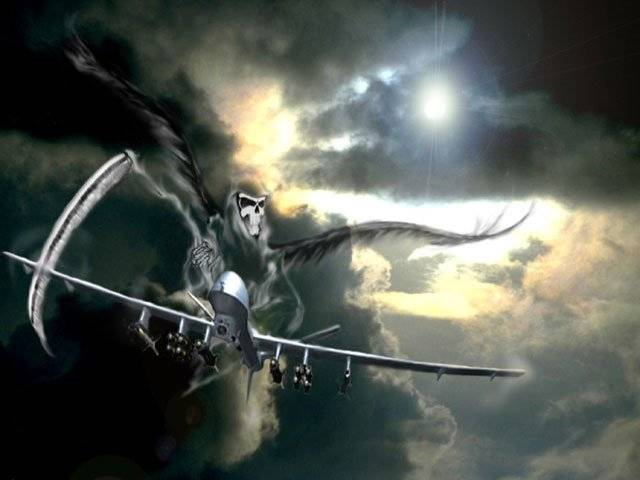The US drone war in Pak has made gains in annihilating Taliban and Al-Qaeda commanders, but the reliance on the unmanned, remotely controlled aircraft risks fanning Islamist violence. While tens of thousands of US troops are fighting the Taliban in Afghanistan, their presence is unwelcome in ally Pakistan and drone strikes have become the main combat tactic against militants on the ground. The Long War Journal, a website tracking the strikes, says US missiles have killed 15 senior Al-Qaeda leaders, and 16 "mid-level" Al-Qaeda and Taliban operatives, since January 2008. Among the scalps was Baitullah Mehsud, the leader of Tehreek-e-Taliban (TTP), the Pakistani Taliban. Despite Mehsud's death in August, the TTP are killing more people than ever and Al-Qaeda leaders Osama bin Laden and Ayman al-Zawahiri -- both believed to be sheltering along the Afghan-Pakistan border -- remain at large. "I don't think the group (TTP) has necessarily been weakened at all," said Ben Venzke, head of IntelCenter, a private contractor working in support of the US and European intelligence communities. "In fact we're seeing more large-scale bombings and attacks in Pakistan than we've ever seen and with a very large casualty count," he said. President Barack Obama has ordered 51,000 extra US troops to Afghanistan, hoping to turn the tide in the war and deny Al-Qaeda sanctuary, but tribal experts fear drone attacks could spawn a war of revenge for years. A Jordanian doctor turned "Al-Qaeda double agent" blew himself up and killed seven CIA agents in Afghanistan on December 30, in the deadliest attack against the US spy agency since 1983. The bomber, Humam Khalil Abu-Mulal al-Balawi, appeared posthumously in a video broadcast Saturday, vowing to avenge Baitullah Mehsud's death. "The way they are now attacking with their drones, trying to hit local militants -- maybe local militants are not a big threat to America but in the future they could become a threat," said tribal expert Rahimullah Yusufzai. Local residents contacted by AFP in North Waziristan -- a district where 22 of the last 24 attacks have struck -- said families lived in fear over the prospect of a Hellfire missile annihilating their home without warning. Yet speaking from Mir Ali, one of the main towns in the Pakistani tribal district, one shopkeeper said the drones did appear to have deterred foreign fighters. "There seems to be only one advantage -- the number of foreigners who used to roam markets in the region freely has reduced considerably," Noor Mohammad told AFP by telephone. Pakistan's unpopular president, Asif Ali Zardari, says the drone attacks undermine the nation's consensus against militants as it struggles with bombings that have killed nearly 3,000 people in less than three years. "Drone attacks are radicalising other people who may not have supported the Taliban," warned Yusufzai. But Lisa Curtis, a research fellow at Washington's conservative Heritage Foundation, said the US administration was more reliant than ever on drones after fears of Al-Qaeda were renewed by the failed Christmas Day plot to blow up an airliner over Detroit. "The long-term costs are that it's raising anti-Americanism in Pakistan, which in turn makes it more difficult for us to cooperate with Pakistan," she said. The United States is increasing pressure on Islamabad to take on groups such as the Haqqani network, which attacks US forces in Afghanistan but is reputed to retain links with Pakistani intelligence. Samina Ahmed, an analyst for the International Crisis Group, said US tactics had yet to spark major protests and cautioned against exaggerating the impact on Zardari's civilian government. "If there were drone attacks on urban centres, major civilian casualties, there would be a public outcry," she said. "It would become a major challenge to the Pakistan military and the Pakistan government."
Saturday, April 20, 2024
31 Qaeda and Taliban operatives killed by drone attacks since January 2008: report

Policitising Tragedy
April 20, 2024
Tehran to Rafah
April 20, 2024
A New Leaf
April 20, 2024
A Tense Neighbourhood
April 19, 2024
Dubai Underwater
April 19, 2024
Dangers of Deepfakes
April 20, 2024
Feudalism
April 20, 2024
Kite tragedy
April 19, 2024
Discipline dilemma
April 19, 2024
Urgent plea
April 19, 2024
ePaper - Nawaiwaqt
Advertisement
Nawaiwaqt Group | Copyright © 2024





